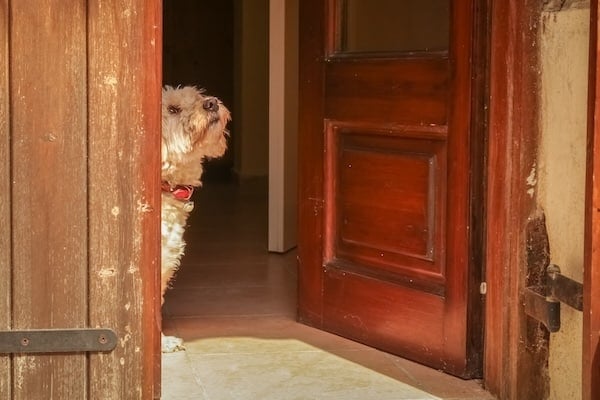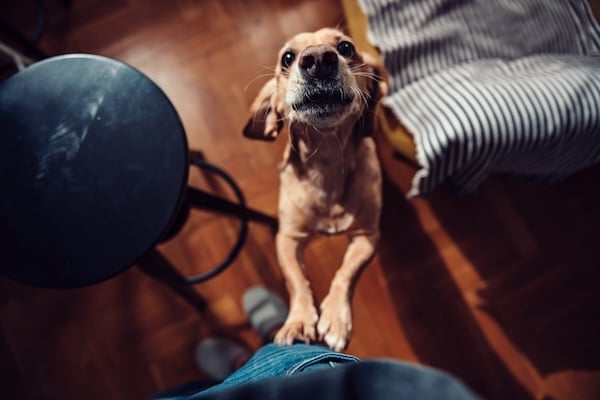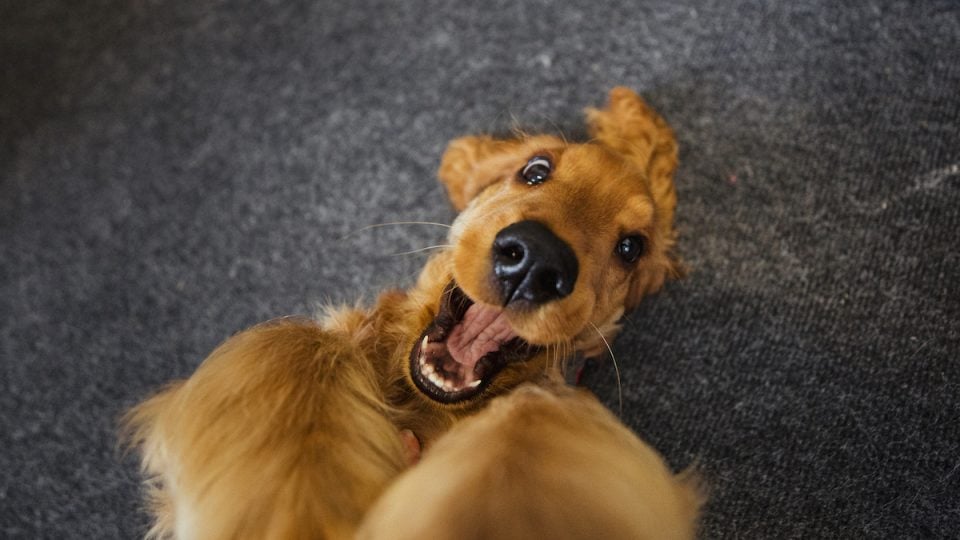There is nothing more awkward than the moment that a guest arrives at your home—and your dog runs them over in excitement. Lots of pet parents know what it’s like to attempt to restrain a pooch while they jump, lunge, or bark at a friend.
Dogs ramp up their reaction to visitors for any number of reasons: excitement, fear, anxiety, or simple overstimulation. No matter the cause, it’s possible to help your dog to stay calm when guests arrive. That means you can better greet friends, delivery drivers, and anyone who shows up at your door—while keeping your sanity too.
To learn more, we spoke with Rhiannon van Lidth de Jeude Roemer, a certified dog trainer with Raintown Dog Training in Vancouver, British Columbia.
What To Do When Guests Arrive
In the long term, training is the best solution for a dog who can’t stay calm around guests. But training takes time. So while you work on a big-picture strategy, here’s how to respond to a dog who’s overexcited around guests in the moment.
- Exercise your dog before your guests arrive. If you know guests are coming, set your dog up for success. “Physical exercise first, followed by a calming (and mentally-stimulating) enrichment activity of licking, sniffing, or chewing, will help ensure a calm dog,” says van Lidth de Jeude Roemer.
- Stay calm. When your pup gets overly excited at the doorbell, it’s normal to react back. But when a pet parent yells or gets physical with an overstimulated dog, it can exacerbate their behaviour.
- Asks your guests to ignore your dog. When your guests arrive, leash your dog and open the door slowly. Ask visitors not to acknowledge your dog. You can even put a sign outside to help your guests know not to react when entering your home.
- Gently remove a too-excited dog. If your dog jumps or barks, let them know that hyper dogs don’t get to say hello. Calmly say: “Too bad!” Gently—but quickly—take your dog by the lead and place them in the closest room, closing the door behind them.
- Let your dog rejoin the gathering after 30 seconds. If your dog immediately goes back to jumping all over guests, repeat: “Too bad!” and take them back to time-out in the closest room.
- Repeat this sequence until your dog is able to be calm.
Once the initial thrill of the arrival is over, most dogs go back to being their regular selves. But if that’s not enough, van Lidth de Jeude Roemer recommends talking to your vet. “For a very anxious dog, situational medication may be a good idea to help them stay calm when guests are over.”

Taospy via iStock
How To Train Your Dog To Be Calm Around Guests
“Barking, door-charging, and other difficult behaviours around guests generally come from a place of over-excitement or fear—or a mixture of both!” says van Lidth de Jeude Roemer. How you train your dog to stay calm at the arrival of a guest depends on how much of each your dog is feeling.
Fear and excitement can both result in vocalisations, barks, and even growls. To tell the difference, watch how your dog is carrying themselves. “Is the body wiggly and loose, indicating an excited dog, or are their movements more nervous, stiff and low to the ground?” van Lidth de Jeude Roemer asks.
Teach over-excited dogs ‘place’
“The best way to deal with over-excitement is to replace the door-charging with a desirable behaviour,” says van Lidth de Jeude Roemer. That means teaching your dog to go to a designated spot when visitors come. Good options are your dog’s bed, a crate, or even a special chair that’s all theirs.
To teach your dog a ‘place’ cue, you’ll:
- Build positive associations around your dog’s ‘place’ by offering toys, treats, and pets when your dog goes there.
- Ask your dog to move on and off their place by tossing treats.
- Start adding a verbal cue when you toss a treat to your dog’s place, as well as a release word when they leave it.
- Start using only the verbal cues and reward with a treat when your dog responds by going to their place.
Once your dog has the basics down, you can start adding distance, duration, and distractions to proof the behaviour against even the most exciting arrivals.
Finally, when guests do come, remember to ask them not to approach your pup when they’re in their safe space. That will keep your dog’s spot a comforting retreat.
Build positive associations for anxious dogs
If your pup is reacting out of fear or anxiety, van Lidth de Jeude Roemer says that the focus should be on building positive associations, as opposed to rewarding good behaviour.
Here’s how to slowly make guests a source of good feelings:
- Introduce your pup to any new visitors in a neutral space, outside the home. This helps to manage any protective instincts that arise when your dog becomes anxious.
- Create a safe space where your dog knows they won’t be approached by guests. A ‘place’ cue can help anxious dogs as well as excitable ones.
- Invite a friend who’s familiar to your dog to sit calmly and toss your dog treats in your home.
- Monitor your dog’s body language for signs of overstimulation or anxiety to know when it’s time to end a session.
- Keep all interactions brief and slowly increase their length over time.
Friends, family, or even a beloved dog walker are great options for practice visitors to help your dog become comfortable.
Train sound-sensitive dogs
For many anxious pups, the ring of the doorbell, heavy footsteps on the front porch, or a knock on the door can all be triggering. These sounds can send them into a state of frenzy before the door even opens. Sound desensitisation is a great training tool to help your pup stay calm.
First, identify your dog’s triggers. For some pups, it may be just one thing. For others, there could be a whole list. One at a time, work through their triggers.
- First perform the action (such as ringing the doorbell). It can also be helpful to start training your pup with a simulated version on low volume. Search online for sound effects that mimic doorbells, knocking, car horns, and more.
- Offer your pup a high-value treat. This is called counter-conditioning, and it helps your pup associate good things—and good behaviours—with the sounds that used to prompt a big response.
- Gradually increase the volume of the sounds over time, rewarding your pup for a calm response (or even no response at all).

Kerkez via iStock
Helpful Tools for Keeping a Dog Calm Around Guests
When it comes to the tools that van Lidth de Jeude Roemer recommends for keeping a dog calm, she keeps it simple: “A cool head and plenty of high-value treats!”
Treats to keep a dog calm
“Staying calm will prevent any extra escalation of the excitement in the moment,” she explains. But treats can offer a little extra support. “Human-grade food such as chopped cheese or shredded chicken is a great option for this high-distraction training setting. You need your treats to be more exciting than the guests are to your dog.”
A tantalising, high-value treat will give your dog something yummy to focus on. You can also use puzzle toys to keep them engaged for longer, or an electronic treat feeder that lets you remotely reward your dog for relaxing on their bed.
Separation tools
If you’re working with a reactive dog, van Lidth de Jeude Roemer says that keeping your pup controlled—and even separated—can be key.
To maintain distance, it can be helpful to invest in a barrier or pet gate that will separate your dog from the front door. A gate won’t calm the flurry of barks and excited prancing, but it will make life easier while you’re working on this behaviour.
Troubleshooting Barking, Jumping, and Nipping
As you help your dog learn to be calm around guests, here are a few tips to troubleshoot specific behaviours.
Dogs who bark
Dogs may be barking out of fear, anxiety, or excitement. No matter the root, creating a tranquil, stress-free environment is key. Stay calm as you greet your guests, and ask them to do the same.
Make sure your pup has a cosy, quiet place to retreat to when they become overwhelmed. Desensitisation and positive reinforcement can both help your pup to stay quiet around guests too.
Dogs who jump
A sturdy lead is the best tool to keep a jumping pup under control. If your dog jumps on you or your guests anyway, ignore it—but make sure to shower a sitting pup with praise and treats.
Wearing your pup out is another great way to keep all four paws on the ground. Take your pup for a long decompression walk or an extended play session before guests arrive. A tired dog is far less likely to jump.
Dogs who nip
Nipping is often seen as an aggressive behaviour, even if your pup doesn’t mean it that way. Many dogs nip out of fear or a drive to protect their home (and you). Like with a jumping dog, you’ll want to keep a nipping dog on a lead and under control. You may even need to put them in an entirely separate space.
Socialising your pup to guests and using counter-conditioning to make positive associations with visitors can also help an anxious or fearful dog greet guests appropriately.
Dogs who can’t settle down
Sometimes just the presence of a new human is enough to keep your pup on edge. Give your pup plenty of exercise before your guests arrive, then ask your pup to lie down in a familiar, calm space, like their bed or a blanket. You can also distract them with a puzzle or licking toy like a KONG. If that’s not enough, separating your pup can help you and your guests enjoy the visit.
How To Get Help
If you’re struggling with any part of your pup’s visitor training, it’s always a good idea to consult with a certified dog trainer. A trainer can help you diagnose your dog’s behaviour and give you tools to guide them—and yourself—toward success.
Remember, too, that training takes time. “Guests entering the home is a HUGE excitement and trigger for many dogs,” says van Lidth de Jeude Roemer. “Remember to tackle this training slowly, and don’t give up if you aren’t seeing fast progress.”



